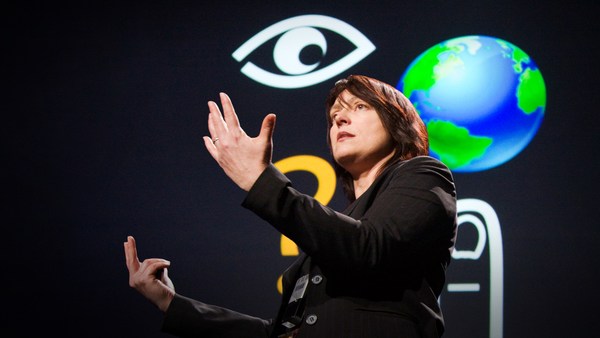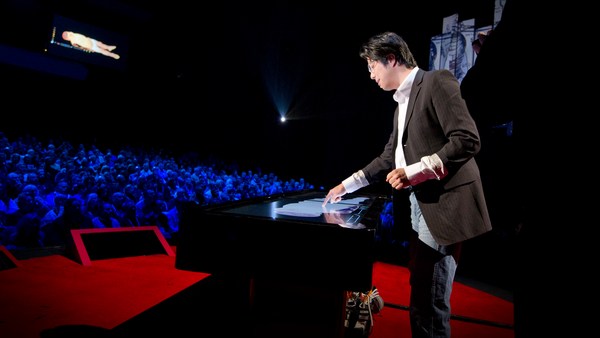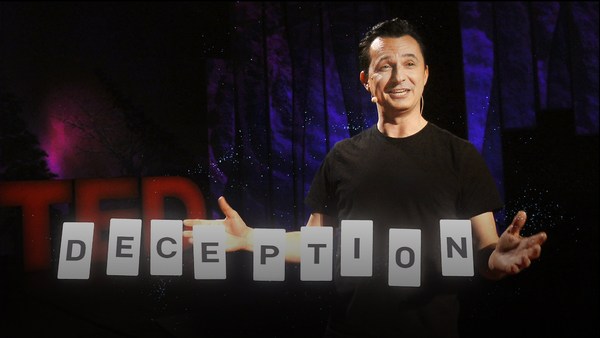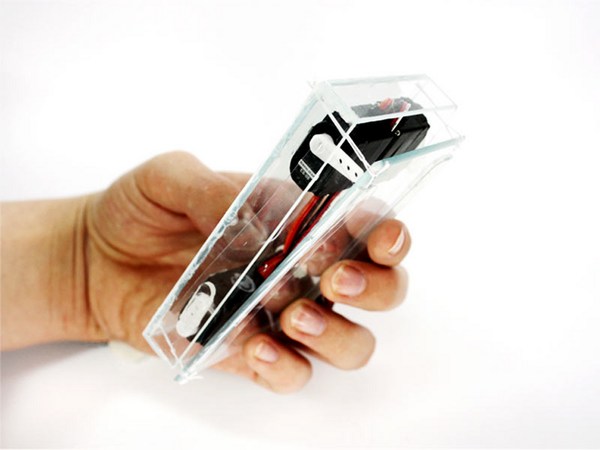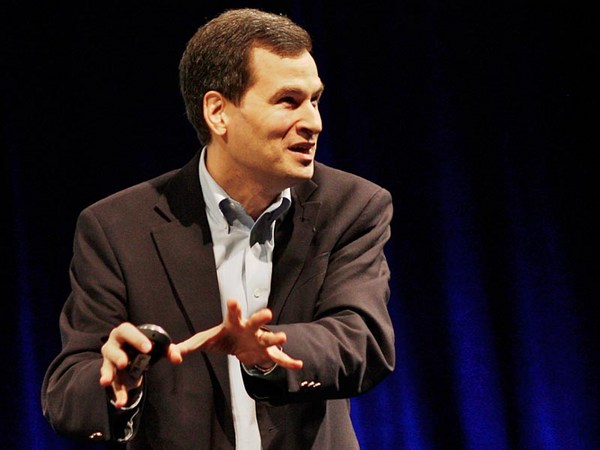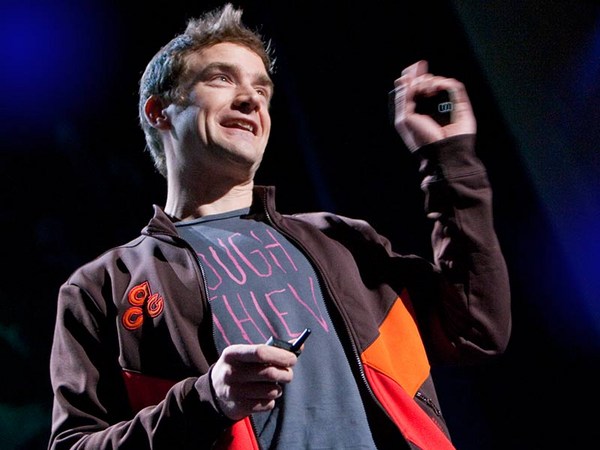So wouldn't it be amazing if our phones could see the world in the same way that we do, as we're walking around being able to point a phone at anything, and then have it actually recognize images and objects like the human brain, and then be able to pull in information from an almost infinite library of knowledge and experiences and ideas.
Well, traditionally that was seen as science fiction, but now we've moved to a world where actually this has become possible.
So the best way of explaining it is to just show it. What you can see over here is Tamara, who is holding my phone that's now plugged in. So let me start with this. What we have here is a painting of the great poet Rabbie Burns, and it's just a normal image, but if we now switch inputs over to the phone, running our technology, you can see effectively what Tamara's seeing on the screen, and when she points at this image, something magical happens.
(Laughter) (Bagpipes) (Bagpipes) (Applause) (Bagpipes) Voice: Now simmer blinks on flowery braes ...
Matt Mills: Now, what's great about this is, there's no trickery here. There's nothing done to this image. And what's great about this is the technology's actually allowing the phone to start to see and understand much like how the human brain does. Not only that, but as I move the object around, it's going to track it and overlay that content seamlessly. Again, the thing that's incredible about this is this is how advanced these devices have become. All the processing to do that was actually done on the device itself.
Now, this has applications everywhere, whether in things like art in museums, like you just saw, or in the world of, say, advertising, or print journalism.
So a newspaper becomes out of date as soon as it's printed. And here is this morning's newspaper, and we have some Wimbledon news, which is great. Now what we can do is point at the front of the newspaper and immediately get the bulletin.
Voice: ... To the grass, and it's very important that you adapt and you, you have to be flexible, you have to be willing to change direction at a split second, and she does all that. She's won this title.
MM: And that linking of the digital content to something that's physical is what we call an aura, and I'll be using that term a little bit as we go through the talk.
So, what's great about this is it isn't just a faster, more convenient way to get information in the real world, but there are times when actually using this medium allows you to be able to display information in a way that was never before possible.
So what I have here is a wireless router. My American colleagues have told me I've got to call it a router, so that everyone here understands — (Laughter) — but nonetheless, here is the device. So now what I can do is, rather than getting the instructions for the device online, I can simply point at it, the device is recognized, and then --
Voice: Begin by plugging in the grey ADSL cable. Then connect the power. Finally, the yellow ethernet cable. Congratulations. You have now completed setup.
(Laughter) MM: Awesome. Thank you.
(Applause)
The incredible work that made that possible was done here in the U.K. by scientists at Cambridge, and they work in our offices, and I've got a lovely picture of them here. They couldn't all be on stage, but we're going to bring their aura to the stage, so here they are. They're not very animated. (Laughter) This was the fourth take, I'm told. (Laughter)
Okay. So, as we're talking about Cambridge, let's now move on to technical advancements, because since we started putting this technology on mobile phones less than 12 months ago, the speed and the processing in these devices has grown at a really phenomenal rate, and that means that I can now take cinema-quality 3D models and place them in the world around me, so I have one over here. Tamara, would you like to jump in?
(Music) (Dinosaur roaring) (Laughter) MM: I should leap in. (Music) (Dinosaur roaring) (Applause)
So then, after the fun, comes the more emotional side of what we do, because effectively, this technology allows you to see the world through someone's eyes, and for that person to be able to take a moment in time and effectively store it and tag it to something physical that exists in the real world. What's great about this is, the tools to do this are free. They're open, they're available to everyone within our application, and educators have really got on board with the classrooms. So we have teachers who've tagged up textbooks, teachers who've tagged up school classrooms, and a great example of this is a school in the U.K. I have a picture here from a video, and we're now going to play it.
Teacher: See what happens. (Children talking) Keep going.
Child: TV. (Children react)
Child: Oh my God.
Teacher: Now move it either side. See what happens. Move away from it and come back to it.
Child: Oh, that is so cool.
Teacher: And then, have you got it again?
Child: Oh my God! How did you do that?
Second child: It's magic.
(Laughter) MM: (Laughs) So, it's not magic. It's available for everyone to do, and actually I'm going to show you how easy it is to do by doing one right now.
So, as sort of — I'm told it's called a stadium wave, so we're going to start from this side of the room on the count of three, and go over to here. Tamara, are you recording? Okay, so are you all ready? One, two, three. Go!
Audience: Whooooooo!
MM: Fellows are really good at that. (Laughs) (Laughter)
Okay. Now we're going to switch back into the Aurasma application, and what Tamara's going to do is tag that video that we just took onto my badge, so that I can remember it forever.
Now, we have lots of people who are doing this already, and we've talked a little bit about the educational side. On the emotional side, we have people who've done things like send postcards and Christmas cards back to their family with little messages on them. We have people who have, for example, taken the inside of the engine bay of an old car and tagged up different components within an engine, so that if you're stuck and you want to find out more, you can point and discover the information.
We're all very, very familiar with the Internet. In the last 20 years, it's really changed the way that we live and work, and the way that we see the world, and what's great is, we sort of think this is the next paradigm shift, because now we can literally take the content that we share, we discover, and that we enjoy and make it a part of the world around us. It's completely free to download this application. If you have a good Wi-Fi connection or 3G, this process is very, very quick.
Oh, there we are. We can save it now. It's just going to do a tiny bit of processing to convert that image that we just took into a sort of digital fingerprint, and the great thing is, if you're a professional user, -- so, a newspaper -- the tools are pretty much identical to what we've just used to create this demonstration. The only difference is that you've got the ability to add in links and slightly more content. Are you now ready?
Tamara Roukaerts: We're ready to go.
MM: Okay. So, I'm told we're ready, which means we can now point at the image, and there you all are.
MM on video: One, two, three. Go!
MM: Well done. We've been Aurasma. Thank you.
(Applause)
